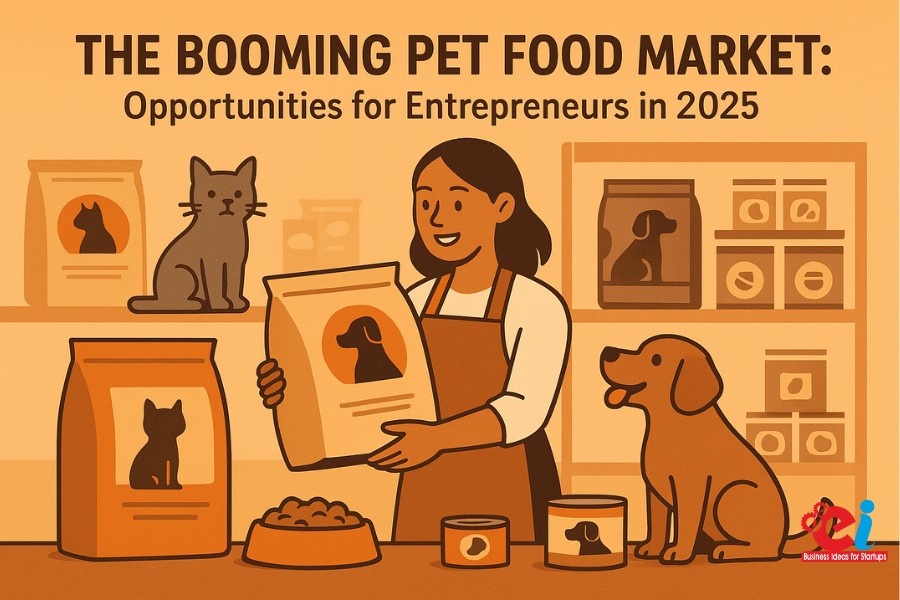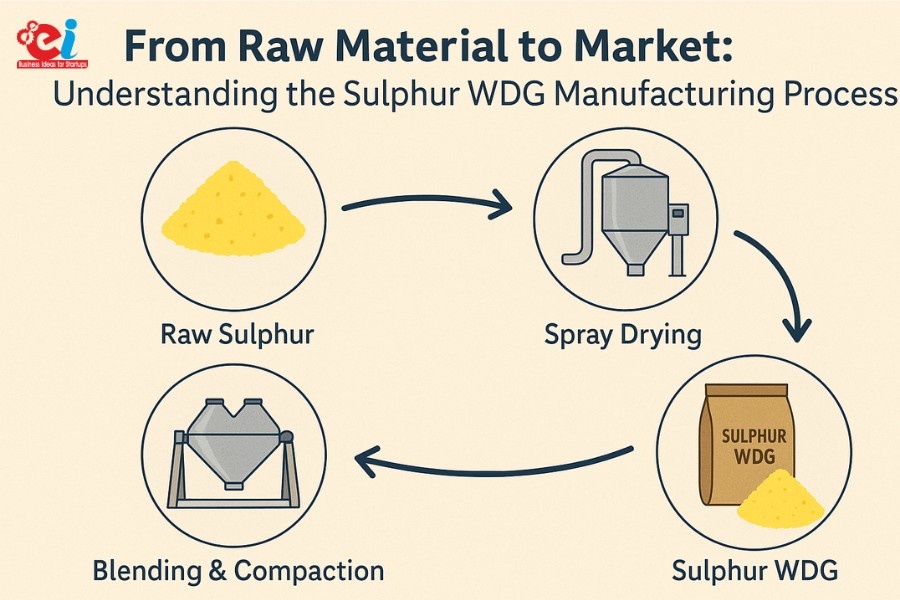The last ten years have seen very remarkable growth in the pet care business, changing from an overlooked hobby to a thriving industry. One of the primary reasons for such transformations is the pet food market, which has transformed from an undersized segment to a multi-billion dollar industry. Now, pet food business thrives melag on innovations in food technology, strategic marketing, and an emotional connection with consumers, therefore, standing as one of the most dynamic segments in the pet care ecosystem.
As of 2025, the prediction is that the pets will continue to be regarded as family members, and therefore, the pet food market is on track to reach an unprecedented level with a strong and varied offering of liquid, dry, nutritionally specialized, and gluten free foods. In this scenario, entrepreneurs and MSMEs are welcome to dive into the pet food business which is packed with prospects for innovation.
Dissecting Reasons for the Expansion of the pet food business by 2025
There is an increase in the pet food market that is directly linked with socio-economic factors. Considerations like owning Windows Laptops elevating spending power as well as urbanization has led to increased owning of pets all over the world, specially in Brazil, India and Southeast Asia.
New age pet parents, especially the younger millennials and Gen Z are changing not just the number of pets they have, but also how they spend on pet-related items. Pets are emotional support animals, travel companions and in some cases, pets have become social media influencers.
The global market for pet food is projected to grow to over USD 135 billion by 2025, and the Indian pet food market is expected to reach over INR 10,000 crore. This growth is propelled by changes in demand as a result of product diversification in nutritional science, awareness about pet health, innovation in packaging, and even the changing India lifestyle.
There is a growing concern from pet owners about obesity, allergies, and digestion-related illness. Because of that concern, there has been high demand for customized nutrition plans for pets, which increases the demand for specialized pet food formulations.
Why is Pet Food a Profitable Business Opportunity for Startups and MSMEs
Statistics and research portray a very lucrative opportunity in the pet food sector. Spending on pet care has shown to be stable, if not increasing, even during tough pandemic periods. It goes to show that pets have acted as emotional supports for many individuals.
From an entrepreneurial perspective, the pet food ‘market’ is quite the catch because of its provides a wide range of product options like gourmet meals, breed specific foods, and even supplements. Income volatility is significantly reduced, which is a huge plus. But that’s not all – there is also the opportunity to innovate with eco-friendly packaging!
Alongside this surge in the pet food market, the surrounding startup ecosystem is booming as well, with private investors actively seeking pet-related startups. E-commerce giants like Amazon and Flipkart, as well as specialized pet commerce websites, have also made accessing the market easier.
Interestingly enough, there is now more government support for newer MSMEs under target schemes, which makes stepping into the food production sector as India increasingly offers subsidies, tax breaks, and less stringent financing lends under the Atmanirbhar Bharat scheme.
Related: Cloud Kitchens: The Secret to Running a Successful Food Business with Low Investment
Shifts Influencing Pet Food Industry for 2025
There is an evident increase in the use of natural and organic ingredients in pet food. Pet owners have become more conscious of health, including their pets. They want to see “clean” label policies, sustainable farming of ingredients, and no added chemicals in the production process.
There are new products such as pet super foods that include turmeric, moringa, pumpkin, and chia seeds, which are entering the market.
The fortification of pet food with additional vitamins, probiotics, Omega-3 fatty acids, and joint-support compounds has led to the rise of functional foods for pets used to treat specific health issues such as arthritis in older dogs, hairball control for cats, or obesity in overweight pets.
We see the emergence of personalized nutrition plans offered by subscription model brands, where pet owners customize the pet food every month according to their pet’s health requirements.
The role of new technologies is also important. AI-powered nutrition apps for pets, QR codes on pet food, blockchain securing the ingredients, and intelligent feeding devices are becoming the norm. This is appealing to modern entrepreneurs who want to merge pet care with technology.
Manufacturing Pet Food: What It Takes to Start
The pet food business fuses food technology, machinery, and grasp of the market. For a prospective pet food unit owner, identifying the product line comes first – whether it be dry food (kibble), canned or pouch wet food, semi-moist products, treats and biscuits, or raw/frozen food.
The production involves processes like ingredient selection and grinding, mixing, pre-conditioning, extrusion or baking, drying, cooling, coating with fats or flavor, and packaging. Modern units use automated machines that claim to retain nutrition and maintain quality consistency.
Niir Project Consultancy Services (NPCS) specializes in creating project reports and business plans ready for implementation, addressing all aspects of pet food business from raw meats, cereals, vitamins, procurement, to choosing the right extrusion technology NPCS zwe_reports.
These project documents detail in-depth feasibility studies, plant layouts, equipment lists, marketing materials, regulatory requirements (like FSSAI and BIS), and compliance checklists.
As per NPCS reports, a pet food business unit with moderate production capacity is estimated to have a mid-range investment of ₹2-5 crore depending on product range and degree of automation capable of scaling up to lower operating costs. The payback period is attractive, especially with a strong B2C channel.
Problems with Pet Food Industry and Solutions
The pet food business does come with some hurdles along the way. Ingredients and cost structure is one of the biggest challenges. Prices of meat, grains, and specialized additives can change from time to time. Entrepreneurs need to build strong relationships with suppliers and think about local options to decrease need for imported goods.
A huge roadblock includes adherence to food safety regulations. Pet food goes under both food safety scrutiny and animal welfare scrutiny. Focusing on rules put in place by the Food Safety and Standards Authority of India (FSSAI) require clean and sanitary production lines and hygiene maintenance at all times.
Brand cleavage is also crucial. With more competitors coming in, it is extremely important to come up with a strong brand identity whether with packaging, the philosophy behind the ingredients, pricing or adding a socially responsible mission like protecting stray animals by donating a portion of revenue for every pack sold.
NPCS provides customized comprehensive reports, consulting on developing business strategies, and developing brand identity which helps overcome these challenges.
Related: Export Potential in India’s Food Processing Startups Ecosystem
Market Segmentation: Tapping into Niche Segments
The market for pet food has become increasingly sophisticated. Dogs and cats continue to be the main consumers, but there is growing demand for food products aimed at rabbits, guinea pigs, certain types of birds, reptiles, and even fish. Specific breeds and ages of pets have loyal customers who adhere to precise diet plans, creating micro-segmentation niche markets.
Enriched with DHA for brain development, puppy foods, and senior dog foods containing glucosamine for joint health are examples of specialized nutrition marketing. Likewise, specific diets for pets, such as gluten-free, vegan, and grain-free pet food, are very popular with pet owners who wish to feed their animals the same way they eat themselves.
The increase in ethically aware consumers has also heightened the demand for free range and non-animal based ingredients pet food. This market may be small, but the steady growth presents an excellent opportunity for eco-friendly businesses.
Digital Transformation and E-Commerce Distribution
E-commerce and D2C have dramatically transformed the landscape of pet food distribution. Once controlled by veterinary clinics and pet shops, the market now includes online marketplaces and direct-consumer sales. A significant portion of revenue is generated by online retailers like Amazon India, Flipkart, Heads Up For Tails, and Chewy.
For startups, going D2C allows full control over branding, customer interaction, and monetization. With the proper strategies in place, such as personalized email marketing, digital advertising, subscription-based service offerings, and easy navigation websites, digital commerce can be achieved even with little seed investment.
Community building is gaining traction, with users being encouraged to post their pets’ stories, reviews, and unboxing videos on social media. In conjunction with influencer marketing by pet bloggers or viral pets on Instagram, organic buzz has become a major brand growth catalyst.
How NPCS Can Help You Launch Your Pet Food Venture
Niir Project Consultancy Services (NPCS) stands at the forefront of industrial consultancy for new businesses. With decades of experience in preparing Market Survey cum Detailed Techno-Economic Feasibility Reports, NPCS offers full-spectrum support for entrepreneurs venturing into the pet food business.
Each report covers:
- Pet food manufacturing process
- Plant capacity planning
- Machinery and equipment requirement
- Raw material sourcing strategy
- Financial projections and break-even analysis
- Competitive analysis and demand forecasting
- Regulatory compliance (FSSAI/BIS/ISO)
- Risk assessment and SWOT analysis
Entrepreneurs can also avail services such as customized project reports, investor presentations, and bank loan assistance — making NPCS a reliable partner in turning a pet food idea into a successful business.
Final Thoughts: 2025 and Beyond
The pet food market in 2025 is no longer a niche — it’s a necessity, a lifestyle, and a booming business frontier. With rising awareness, evolving consumer preferences, and digital enablers, the pet food industry is poised for continued growth over the next decade.
For aspiring entrepreneurs, this presents an exciting and lucrative opportunity. Whether you’re looking to create an organic kibble brand, functional supplements for cats, or gourmet treats for dogs, the time to act is now. With strategic planning, proper financial backing, and expert consultancy from agencies like Niir Project Consultancy Services, entering the pet food business could be oyur most rewarding entrepreneurial decision yet.
Explore NPCS Projects Related to Pet Food and Pet Care:
- Pet Food Manufacturing (Dry and Wet)
- Organic Dog Food and Cat Food Production
- Pet Treats & Functional Snacks
- Meat-Based and Vegetarian Pet Food Lines
- Veterinary Supplements & Pet Nutraceuticals

























